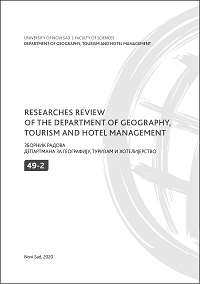UTILIZING LANDSAT-8 SENSOR OPERATIONAL LAND IMAGE DATA FOR HYDROTHERMAL ALTERATION MAPPING WITHIN ANKA SCHIST BELT, NORTHWESTERN NIGERIA
UTILIZING LANDSAT-8 SENSOR OPERATIONAL LAND IMAGE DATA FOR HYDROTHERMAL ALTERATION MAPPING WITHIN ANKA SCHIST BELT, NORTHWESTERN NIGERIA
Author(s): Ibrahim Aliyu Kankara, Umaru Aliyu OhinowiSubject(s): Applied Geography, Geomatics
Published by: Prirodno-matematički fakultet, Univerzitet u Novom Sadu
Keywords: Band Ratio; Principal Component Analysis; False Colour Composite; Landsat-8 OLI
Summary/Abstract: Exploring for mineral deposits within the Anka Schist Belt involves the use of traditional geological techniques such as geochemical and geophysical studies that are very expensive and time consuming. There is therefore need for a better alternative that will provide accurate and reliable information with cost effective and time efficient solution. This effort seeks to explore the potential of remotely sensed digital data in highlighting mineralized zones through hydrothermal alteration studies. Landsat 8 OLI data covering the investigated area was used to detect and map locations of hydrothermal alterations. Image processing methods used were spectral enhancement, false colour composites, band rationing and Principal Component Analysis. Results of false colour composites of band 5: 7: 3 highlighted generally locations of hydrothermal alterations. Band ratios of 4/2, 6/7 and 6/5 revealed the presence of ferric iron minerals, clay rich minerals and ferrous minerals respectively. Principal Components (PCs) of two sets of images (2, 4, 5, 7 H-image and 2,5,6,7 F-image) depicting iron-oxide and hydroxyl mineral deposits as bright pixels were generated. Colour composite of H, F and H+F images enhanced the location of the mineral deposits, by showing areas of mineralization in dark blue (Fe rich), bright yellow (clay rich) and white (Fe and clay rich areas) pixels. Field coordinates of mining locations were superimposed on the remote sensing generated mineral map. The results were found to be in tune. This study recommends the use of remote sensing and geospatial technology in mineral studies through hydrothermal alteration within the basement complex rocks of Nigeria.
Journal: Zbornik radova Departmana za geografiju, turizam i hotelijerstvo
- Issue Year: 49/2020
- Issue No: 2
- Page Range: 127-149
- Page Count: 23
- Language: English

